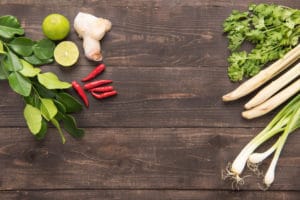How to Successfully Grow Indian Spices in Your Yard
Indian food is popular for its rich flavors and uniquely blended spices in both meat and vegetarian dishes. Even though cooking these savory meals may be a new endeavor for many, just like with many other recipes, you can easily become adept at their preparation with practice. What also influences your success at creating full flavored favorites is the freshness of your ingredients- all of which are easy to grow and cultivate in your own backyard.

Growing fresh vegetables, and the complimentary full-bodied spices that make Indian cuisine so popular, is not a complicated process. All you need is a little knowledge of basic gardening and which spices to plant to set yourself on the fast track to your own fresh cooking options.
Basic Garden Cultivation Needs
If you already have a garden, then you know that some basic tools are needed for successful care and cultivation of your vegetation. Even if you are new to gardening, you’ll want to consider a few useful items to have handy to care for your growing plants. No great cost or shed full of products are needed for healthy plant growth or harvest, just a few dependable, quality options for regular use.
Obviously, the proper sized garden plot or containers are needed for the plants, as well as a sunny area for them to thrive and produce. But you will also need to ensure they are well watered, regularly weeded, and fertilized to support the best harvest possible. Choose a dependable hose that works for your space and is easily accessible for regular watering. You also may want to invest in a small tool set, such as a hand trowel, hand rake, or small spade to help with weeding. Using the proper fertilizer is also useful; this is easy to determine as fertilizers are well labeled for their use.
Most Popular Spices Used in Indian Cuisine
Indian food is famous for its aromatic herb and spice blend, as well as how well these flavors marry both meats and vegetables. Although not all flavors are considered a curry, the term curry is used for many of the most popular dishes well known world-round and describes the artistic blending of very specific spices to create these delicacies.
Ginger, turmeric, chili, bay, coriander, mint, and fenugreek feature prominently in many curries and are a great place to start when planning on Indian spice garden. Others, which I will mention below, may present a challenge, but are well worth the effort once you hone your green thumb.
Which Spices to Plant and How to Care for Them
To get started with your spice garden, first look for those plants that are more readily available in your growing season planting zone. If you are adept at gardening and caring for out of zone plants, then you might want to consider those options that require a little more attention in order to thrive for spice harvest. These aren’t a complete list by any means, but serve as an excellent foundation to get started with influential aromatic flavors in your cooking.
Ginger
Grow your own ginger from a root you get from a grocery store or online order. Choose one with a pointed growing bud on the end and plant it bud-end up in moist soil. To influence rhizomes you’ll need to keep it growing through a few seasons, but you can definitely begin to harvest some leaves to provide a more mild ginger flavor to your cooking.
Chili
Choose your chilis based on heat and personal preferences and grow them in just about anywhere! They even grow well through the winter in a sunny window, but ripe chilis dry and store easily for year round use.
Sweet Bay
Sweet bay is actually a tree but grows well from small cuttings in containers in just about any climate as long as it is protected in cooler weather or brought indoors and placed in a sunny window. Mature leaves can be harvested for use at any time.
Coriander
Coriander seeds are actually known as cilantro in many areas and can be grown as an annual herb and spice in just about any climate!
Mint
Various mints are also incredibly easy to grow in just about any climate and usually grow as a perennial. They can take over the space they are grown in so many people prefer to keep them in a container.
Fenugreek
This legume is often sprouted to use in fresh salads, but the small seeds are excellent for flavoring curry and pickling solutions.
Turmeric
Turmeric can be grown like ginger, with a period of time before rhizome roots are ready to harvest. In the meantime you can use leaves.
Lemongrass
Lemongrass, like any grass, is easy to grow and cultivate. Plant from seed or plant the bulb of the stems you find in a store after using the leafy greens.
First Seen here: How to Successfully Grow Indian Spices in Your Yard
Comments
Post a Comment